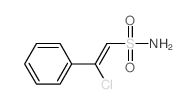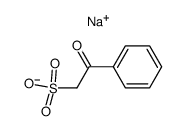Pifithrin-µ

Pifithrin-µ structure
|
Common Name | Pifithrin-µ | ||
|---|---|---|---|---|
| CAS Number | 64984-31-2 | Molecular Weight | 181.212 | |
| Density | 1.4±0.1 g/cm3 | Boiling Point | 351.7±25.0 °C at 760 mmHg | |
| Molecular Formula | C8H7NO2S | Melting Point | 135.0 to 139.0 °C | |
| MSDS | Chinese USA | Flash Point | 166.5±23.2 °C | |
| Symbol |

GHS07 |
Signal Word | Warning | |
Use of Pifithrin-µPifithrin-μ is an inhibitor of p53 and HSP70, with antitumor and neuroprotective activity. |
| Name | 2-Phenylacetylenesulfonamide |
|---|---|
| Synonym | More Synonyms |
| Description | Pifithrin-μ is an inhibitor of p53 and HSP70, with antitumor and neuroprotective activity. |
|---|---|
| Related Catalog | |
| Target |
HSP70 MDM-2/p53 |
| In Vitro | Pifithrin-μ (10 μM) is a p53 inhibitor, which inhibits p53 binding to mitochondria by reducing its affinity to antiapoptotic proteins Bcl-xL and Bcl-2 but has no effect on p53-dependent transactivation, activity of caspases 2, 8, 9 and 10 in a cell-free system, or NF-κB-dependent transcription[1]. Pifithrin-μ (PES) time- and dose-dependently reduces viability in A549 cells, with IC50s of 44.9 and 25.7 µM at 24 h and 48 h. Pifithrin-μ (20 μM) suppresses the cell migration, induces cell cycle arrest and cell apoptosis in A549 and H460 cells. Pifithrin-μ (10 or 20 µM) inhibits activities of AKT, ERK, and Hsp70 in A549 and H460 cells. Pifithrin-μ (20 µM) sensitizes A549 and H460 cell lines to TRAIL-induced cell proliferation inhibition and apoptosis[2]. |
| In Vivo | Pifithrin-μ (40 mg/kg, i.p.) shows no protective effect against doses of radiation that cause gastrointestinal syndrome in mice[1]. Pifithrin-μ (PES, 10 mg/kg) shows antitumor effect in mice bearing A549 cells[2]. Pifithrin-μ exhibits neuroprotective effect with the P53-inhibitor pifithrin-μ after cardiac arrest in a rodent model[3]. |
| Cell Assay | The cell viability is determined by the Cell Counting Kit-8 assay. Briefly, A549 and H460 cells are incubated in 96-well plates at a density of 5 × 103 per 100 µL of culture medium overnight. After treated with indicated concentration of Pifithrin-μ for 24 and 48 h, 10 µL of tetrazolium substrate are added to each well of the plate. After incubation at 37°C for 1 h, the absorbance is recorded at a wavelength of 450 nm using a microplate reader. Each experiment is determined in triplicate and repeated at least three times[2]. |
| Animal Admin | Mice[2] A549 cells (1 × 107) are suspended in Matrigel and inoculated subcutaneously into the mice. Twelve mice bearing evident tumors are arbitrarily assigned to PBS control group and Pifithrin-μ treatment groups (six mice per group). When tumors reach a size of ∼5×5 mm2, mice are treated with either a single of intraperitoneal injection of Pifithrin-μ (20 mg/kg) or PBS every two days. After 3-week treatment, mice are euthanized with carbon dioxide. Tumor burdens are evaluated by measuring body weight, tumor weight, and tumor volume. Tumor volume is determined as 0.5 × length × width2. Tumor samples are collected and fixed in 10% neutral buffered formalin. Hematoxylin and eosin staining and immunohistochemistry for histological analysis of tumor samples are measured[2]. |
| References |
| Density | 1.4±0.1 g/cm3 |
|---|---|
| Boiling Point | 351.7±25.0 °C at 760 mmHg |
| Melting Point | 135.0 to 139.0 °C |
| Molecular Formula | C8H7NO2S |
| Molecular Weight | 181.212 |
| Flash Point | 166.5±23.2 °C |
| Exact Mass | 181.019745 |
| PSA | 68.54000 |
| LogP | 2.00 |
| Vapour Pressure | 0.0±0.8 mmHg at 25°C |
| Index of Refraction | 1.634 |
| Storage condition | 2-8°C |
| Water Solubility | DMSO: soluble >10mg/mL, clear |
| Symbol |

GHS07 |
|---|---|
| Signal Word | Warning |
| Hazard Statements | H302-H315-H319-H335 |
| Precautionary Statements | P261-P305 + P351 + P338 |
| Personal Protective Equipment | dust mask type N95 (US);Eyeshields;Gloves |
| Hazard Codes | Xn: Harmful; |
| Risk Phrases | 22-36/37/38 |
| Safety Phrases | 26 |
| RIDADR | NONH for all modes of transport |
| HS Code | 2935009090 |
|
~% 
Pifithrin-µ CAS#:64984-31-2 |
| Literature: Bulletin of the Chemical Society of Japan, , vol. 50, p. 2346 - 2350 |
|
~% 
Pifithrin-µ CAS#:64984-31-2 |
| Literature: Bulletin of the Chemical Society of Japan, , vol. 50, p. 2346 - 2350 |
| Precursor 2 | |
|---|---|
| DownStream 0 | |
| HS Code | 2935009090 |
|---|---|
| Summary | 2935009090 other sulphonamides VAT:17.0% Tax rebate rate:9.0% Supervision conditions:none MFN tariff:6.5% General tariff:35.0% |
|
Cell death induced by 2-phenylethynesulfonamide uncovers a pro-survival function of BAX.
Cancer Lett. 354(1) , 115-21, (2014) PES (2-phenylethynesulfonamide) was initially identified as an inhibitor of p53 translocation to mitochondria and named Pifithrin-µ. Further studies showed that PES selectively killed tumour cells and... |
|
|
A Tetrahymena Hsp90 co-chaperone promotes siRNA loading by ATP-dependent and ATP-independent mechanisms.
EMBO J. 34(4) , 559-77, (2015) The loading of small interfering RNAs (siRNAs) and microRNAs into Argonaute proteins is enhanced by Hsp90 and ATP in diverse eukaryotes. However, whether this loading also occurs independently of Hsp9... |
|
|
Cross-Presentation of the Oncofetal Tumor Antigen 5T4 from Irradiated Prostate Cancer Cells--A Key Role for Heat-Shock Protein 70 and Receptor CD91.
Cancer. Immunol. Res. 3 , 678-88, (2015) Immune responses contribute to the success of radiotherapy of solid tumors; however, the mechanism of triggering CD8(+) T-cell responses is poorly understood. Antigen cross-presentation from tumor cel... |
| 2-Phenylethynesulfonamide |
| Pifithrin-mu |
| 2-Phenylacetylenesulfonamide |
| Phenyl-ethynesulfonic acid amide |
| Ethynesulfonamide, 2-phenyl- |
| Phenylethynsulfonic acid amide |
| PFTmu |
| Pifithrin-μ |

